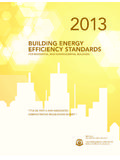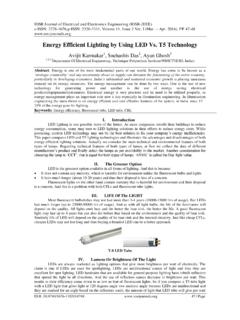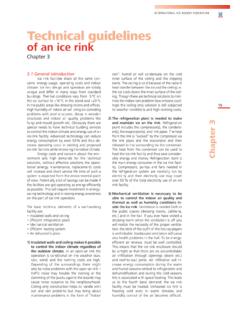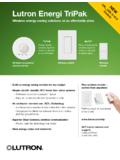Transcription of Connecticut Building Standard Guidelines …
1 Connecticut Building Standard Guidelines compliance Manual for High Performance Buildings August 2009. Prepared For The Connecticut Office of Policy and Management by: 5 Militia Drive Lexington, MA 02421. With Technical Support provided by 13 Railroad Square, Suite 504. Haverhill, MA 01832-5716. Connecticut compliance Manual for High Performance Buildings This publication was commissioned and finalized by the Connecticut Office of Policy and Management, in consultation with the Department of Public Works, the Department of Public Safety, the Department of Environmental Protection, and the Institute for Sustainable Energy at Eastern Connecticut State University. It is designed to provide accurate and authoritative information with regard to the subject matter covered. However, although great care has been taken in the compilation and publication of this manual, it is published with the understanding that (1) the publisher and authors make no guarantee that the manual meets all federal, state, and local statutory, regulatory, or other requirements, and (2) the publisher and authors are not engaged in rendering professional advice via this manual or their work and/or affiliation with the State of Connecticut .
2 The publisher and authors cannot be responsible for errors or omissions or any agency's interpretations, applications, and changes of regulations or specifications described in this publication. Use of any provision contained herein is the sole responsibility of the specifier and project owner. The authors wish to acknowledge the support of the Kendall Foundation and the Connecticut Green Building Council for support in advancing the development of this manual. Published by: Northeast Energy Efficiency Partnerships, Inc. 5 Militia Drive Lexington, Massachusetts 02421. and Energy & Resource Solutions 13 Railroad Square, Suite 504. Haverhill, Massachusetts 01832. This material is based upon work supported by the U. S. Department of Energy under grant award # DE-FG41-06R130172. ii Connecticut compliance Manual for High Performance Buildings Contents Introduction .. iv Regulation .. v Mandatory Requirements All Buildings Building Commissioning ..1. Integrated Design Process.
3 6. Energy Performance ..9. Energy Star Specification .. 11. Indoor Air Quality Management Plan .. 13. Water Usage ..15. Recyclable Materials .. 17. Erosion and Sedimentation Control ..18. No Smoking ..20. Integrated Pest Management 21. Chlorofluorocarbon (CFC) Based Refrigerant ..23. Minimum Ventilation Requirements ..25. Building Standard Optional Strategies State Facilities Energy Efficiency and Renewable Energy ..26. Indoor Environment ..31. Water Efficiency . 36. Recycling, Reuse, and Sustainability ..38. Site Selection and Development . 41. Operations and Procedures/Innovation 48. Mandatory Requirements Schools Acoustical standards ..50. Properly Locate Outside Air Intakes ..51. Install Gas Equipment with Electronic Ignition ..52. Use Low VOC Materials 53. Environmental Assessment of Building Site 54. HEPA Vacuuming ..56. Building Standard Optional Strategies Schools Energy Efficiency and Renewable Energy ..57. Indoor Environment ..62. Water Efficiency .. 67. Recycling, Reuse, and Sustainability.
4 69. Site Selection and Development . 72. Operations and Procedures/Innovation .. 78. Regulation compliance Alternative for Building Standard Options .80. compliance Checklist-State Facilities ..82. compliance Checklist-Schools .. 85. High Performance Buildings Glossary ..88. iii Connecticut compliance Manual for High Performance Buildings Introduction This handbook has been developed to assist state and local Building code officials, architects, and contractors in complying with State of Connecticut Regulation Section 16a-38k-1 through 9: The Establishment of High Performance Building Construction standards for State-Funded Buildings. It contains Guidelines and requirements for meeting both mandatory and optional strategies to ensure compliance with the regulation. This handbook was prepared to allow periodic updates as referenced materials are modified and updated. These regulations were developed by the Connecticut Office of Policy and Management in consultation with the Department of Public Works, the Department of Environmental Protection, the Department of Public Safety, and the Institute for Sustainable Energy at Eastern Connecticut State University.
5 The regulation sets environmental and energy efficiency standards for state-funded facilities that are newly constructed or are undergoing major renovations. For state agency buildings, this regulation includes twelve mandatory requirements that must be met by all projects. In addition, there are sixty optional strategies, twenty-six of which must be met in order for the project to be in compliance . For schools, the regulation requires buildings to meet the twelve mandatory requirements that state agency buildings must meet plus six additional mandatory measures. Schools then must meet twenty-eight of fifty-nine optional strategies. The regulations were adopted primarily to require state-funded buildings to be built utilizing a high performance Building Standard equivalent to that of the United States Green Buildings Council (USGBC) Leadership in Energy and Environment Design (LEED) Green Building Rating System -Silver. This rating system primarily focuses on five areas of concern: sustainable site development, water savings, energy efficiency, materials selection, and indoor environmental quality.
6 Complying with these regulations will produce buildings that consume less energy, conserve natural resources, are more comfortable, healthier, and are easier and less costly to maintain. Disclaimer: This report was prepared in part as an account of work sponsored by an agency of the United States Government. Neither the United States Government nor any agency thereof, nor any of their employees, makes any warranty, express or implied, or assumes any legal liability or responsibility for the accuracy, completeness, or usefulness of any information, apparatus, product, or process disclosed, or represents that its use would not infringe privately owned rights. Reference herein to any specific commercial product, process or service by trade name, trademark, manufacturer, or otherwise does not necessarily constitute or imply its endorsement, recommendation, of favoring by the United States Government, or any agency thereof. The views and opinions of authors expressed herein do not necessarily state or reflect those of the United States Government or any agency thereof.
7 Iv Connecticut compliance Manual for High Performance Buildings State of Connecticut REGULATION. of NAME OF AGENCY. Office of Policy and Management Concerning SUBJECT MATTER OF REGULATION. The Establishment of High Performance Building Construction standards for State- Funded Buildings The Regulations of Connecticut State Agencies are amended by adding sections 16a-38k- 1 to 16a-38k-9, inclusive, as follows: (NEW) Section 16a-38k-1. Definitions As used in section 16a-38k-1 to section 16a-38k-9, inclusive, of the Regulations of Connecticut State Agencies: 1) ASHRAE means the American Society of Heating, Refrigerating, and Air Conditioning Engineers;. 2) Building envelope systems means the part of the Building that represents the barrier between the outdoor and indoor environments, and includes such components as windows, doors, walls, and roofs. 3) Carpet and Rug Institute means a trade association that represents manufacturers and suppliers of carpets, rugs, and floor coverings.
8 4) Chlorofluorocarbons or CFCs means a class of chemical compounds containing chlorine, fluorine, and carbon that were commonly used as refrigerants and that damage the earth's ozone layer;. 5) Class I Renewable Energy Source means Class I Renewable Energy Source . as defined in section 16-1(a)(26) of the Connecticut General Statutes;. 6) Commissioner means the commissioner of the Department of Public Works;. 7) Commissioning means the process of verification that the Building 's systems perform as designed and according to project requirements and construction documents, including assurances that the specified systems are installed properly and adjusted correctly;. v Connecticut compliance Manual for High Performance Buildings 8) Composite wood and agrifiber products means particleboard, medium density fiberboard, plywood, wheatboard, strawboard, panel substrates, and door cores;. 9) Connecticut State Building Code means the state Building code as adopted under Section 29-252 of the Connecticut General Statutes.
9 10) Connecticut Building Standard Guidelines compliance Manual for High Performance Buildings means a reference and support manual prepared to assist Building teams to comply with sections 16a-38k-1 to 16a-38k-9 inclusive of the Regulations of Connecticut State Agencies, and available electronically on the Connecticut Office of Policy and Management website;. 11) Energy Star means a program developed jointly by the United States Department of Energy and the United States Environmental Protection Agency that labels products to designate high levels of energy efficiency;. 12) Forest Stewardship Council means a not-for profit, international membership- based organization that accredits third-party organizations to certify that forest managers and forest product producers support responsible forest management;. 13) Green Globes system means a green Building design and management tool that includes a rating system and guide to encourage the integration of environmentally friendly design into buildings.
10 14) Green Label Plus means an independent testing program developed by the Carpet and Rug Institute to provide assurances that carpet and adhesive products meet stringent criteria for low chemical emissions;. 15) Halons means a class of organic chemical compounds that contain carbon, fluorine and bromine and may contain chlorine and are destructive to the earth's ozone layer;. 16) Heat island effect means local air and surface temperatures that are higher than nearby natural areas as a result of heat absorbing surfaces at a site;. 17) Hydrochlorofluorocarbons or HCFCs means a class of chemical compounds containing hydrogen, chlorine, fluorine and carbon that are commonly used as substitute refrigerants to Chlorofluorocarbons because they are less damaging to the earth's ozone layer;. 18) Institute for Sustainable Energy means the Institute for Sustainable Energy at Eastern Connecticut State University;. 19) Leadership in Energy and Environmental Design or LEED means a rating system developed by the U.
















